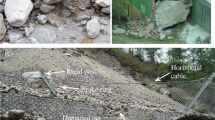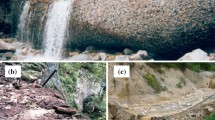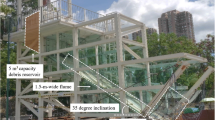Abstract
Conventionally, flexible barriers are rated based on their ability to resist a free-falling boulder with a particular input energy. However, there is still no well-accepted approach for evaluating performance of flexible barrier under debris flow impact. In this study, a large-nonlinear finite-element model was used to back-analyze centrifuge tests to discern the effects of impact material type, barrier stiffness, and flow aspect ratio (flow height to flow length) on the reaction force between the impacting medium and flexible barrier. Results show that, in contrast to flexible barriers for resisting rockfall, the normal impact force induced by the highly frictional and viscous debris is insensitive to barrier stiffness. This is because the elongated distributions of kinetic energy are mainly dissipated by the internal and boundary shearing, and only a small portion is forwarded to the barrier. Furthermore, a new stiffness number is proposed to characterize the equivalent stiffness between a debris flow or a boulder, and a flexible barrier. Under the circumstance of an extremely elongated debris flow event, i.e., low aspect ratio, the load on a barrier is dominated by the static component and thus not sensitive to the barrier stiffness.
Similar content being viewed by others
References
AECOM (2012) Detailed Study of the 7 June 2008 Landslides on the Hillside above Yu Tung Road, Tung Chung (GEO Report No. 271). Geotechnical Engineering Office, Hong Kong SAR Government.
Armanini A, Larcher M, Odorizzi M (2011) Dynamic impact of a debris flow front against a vertical wall. In: Proceedings of the 5th International Conference on Debris-Flow Hazards Mitigation: Mechanics, Prediction and Assessment. Padua, Italy. pp 1041–1049.
ARUP (2013) Pilot Numerical Investigation of the Interactions between Landslide Debris and Flexible Debris-resisting Barriers. Report prepared for Geotechnical Engineering Office, Hong Kong SAR Government. ARUP (Hong Kong).
Ashwood W, Hungr O (2016) Estimating the total resisting force in a flexible barrier impacted by a granular avalanche using physical and numerical modeling. Canadian Geotechnical Journal 53(10): 1700–1717. https://doi.org/10.1139/cgj-2015-0481
Austrian Standards Institute (2010) ONR 24801. Protection works for torrent control: Static and dynamic loads (impacts), Vienna (in German).
Berger C, McArdell BW, Schlunegger F (2011) Direct measurement of channel erosion by debris flows, Illgraben, Switzerland. Journal of Geophysical Research: Earth Surface 116(F1). https://doi.org/10.1029/2010JF001722
Blanco-Fernandez E, Castro-Fresno D, del Coz Diaz JJ, et al. (2016) Flexible membranes anchored to the ground for slope stabilisation: Numerical modelling of soil slopes using SPH. Computers and Geotechnics: 78: 1–10. https://doi.org/10.1016/j.compgeo.2016.04.014
Bowman ET, Laue J, Imre B, et al. (2010) Experimental Modelling of Debris Flow Behaviour Using a Geotechnical Centrifuge. Canadian Geotechnical Journal 47(7): 742–762. https://doi.org/10.1139/T09-141
Brighenti R, Segalini A, Ferrero AM (2013) Debris flow hazard mitigation: a simplified analytical model for the design of flexible barriers. Computers and Geotechnics 54: 1–15. https://doi.org/10.1016/j.compgeo.2013.05.010
Bugnion L, Wendeler C (2010) Shallow landslide full-scale experiments in combination with testing of a flexible barrier. WIT Transactions on Engineering Sciences 67:161–173. https://doi.org/10.2495/DEB100141
Canelli L, Ferrero AM, Migliazza M, et al. (2012) Debris flow risk mitigation by the means of rigid and flexible barriers-experimental tests and impact analysis. Natural Hazards and Earth System Sciences 12: 1693–1699. https://doi.org/10.5194/nhess-12-1693-2012
Castanon-Jano L, Blanco-Fernandez E, Castro-Fresno D, et al. (2017) Energy dissipating devices in falling rock protection barriers. Rock Mechanics and Rock Engineering 50(3): 603–619. https://doi.org/10.1007/s0060
Chan SL, Zhou ZH, Liu YP (2012) Numerical Analysis and Design of Flexible Barriers Allowing for Sliding Nodes and Large Deflection Effects. In: CK Lau, E Chan and J Kwan (eds). In: Proceedings of the One Day Seminar on Natural Terrain Hazards Mitigation Measures, Hong Kong. The Association of Geotechnical and Geoenvironmental Specialists (Hong Kong) Limited. pp 29–43.
Chen HX, Zhang LM Zhang S, et al. (2013) Hybrid simulation of the initiation and runout characteristics of a catastrophic debris flow. Journal of Mountain Science 10(2): 219–232. https://doi.org/10.1007/s11629-013-2505-z
Choi CE, Au-Yeung SCH, Ng CWW, et al. (2015) Flume investigation of landslide granular debris and water runup mechanisms. Géotechnique Letters 5(1): 28–32. https://doi.org/10.1680/geolett.14.00080
DeNatale JS, Iverson RM, Major JJ, et al. (1999) Experimental testing of flexible barriers for containment of debris flows. US Department of the Interior, US Geological Survey.
Donea J, Giuliani S, Halleux JP (1982) An arbitrary Lagrangian-Eulerian finite element method for transient dynamic fluid-structure interactions. Computer methods in applied mechanics and engineering 33(1–3): 689–723. https://doi.org/10.1016/0045-7825(82)90128-1
EOTA. 2016. Flexible Kits for Retaining Debris Flows and Shallow Landslides/Open Slope Debris Flows. EAD340020-00-0106. Available online at: https://doi.org/www.eota.eu/handlers/download.ashx?filename=ead-in-ojeu%2fead-340020-00-0106-ojeu2016.pdf (Accessed on 19 June 2019)
Faug T (2015) Macroscopic force experienced by extended objects in granular flows over a very broad Froude-number range. European Physical Journal E 38(24): 1–10. https://doi.org/10.1140/epje/i2015-15034-3
GEO (2012) Technical Guidelines on Empirical Design of Flexible Barriers for Mitigating Natural Terrain Open Hillslope Landslide Hazards. Guidance Note No. 37 (TGN 37). Geotechnical Engineering Office, HKSAR Government. Available online at: https://doi.org/www.cedd.gov.hk/eng/publications/guidance_notes/doc/TGN37.pdf (Accessed on 19 June 2019)
Hallquist JO (2007) LS-DYNA keyword user’s manual. Livermore Software Technology Corporation. p 970.
Huebl J, Nagl G, Suda J, et al. (2017) Standardized Stress Model for Design of Torrential Barriers under Impact by Debris Flow (According to Austrian Standard Regulation 24801). International Journal of Erosion Control Engineering 10(1): 47–55. https://doi.org/10.13101/ijece.10.47
Hübl J, Suda J, Proske D, et al. (2009) Debris flow impact estimation. In: Proceedings of the 11th International Symposium on Water Management and Hydraulic Engineering, Ohrid, Macedonia. pp 1–5.
Hungr O (1995) A model for the runout analysis of rapid flow slides, debris flows, and avalanches. Canadian Geotechnical Journal 32(4): 610–623. https://doi.org/10.1139/t95-063
Hungr O (2008) Simplified models of spreading flow of dry granular material. Can Geotech J 45(8): 1156–1168. https://doi.org/10.1139/T08-059
Ishikawa N, Inoue R, Beppu M, et al. (2010) Dynamic load characteristics of debris flow model using different gravel size distribution. In: Proceedings of INTERPRAEVENT. pp 207–216.
Iverson RM (1997) The physics of debris flows. Reviews of geophysics 35(3): 245–296. https://doi.org/10.1029/97RG00426
Iverson RM, Logan M, Denlinger RP (2004) Granular avalanches across irregular three — dimensional terrain: 2. Experimental tests. Journal of Geophysical Research: Earth Surface 109(F1). https://doi.org/10.1029/2003JF000084
Iverson RM (2015) Scaling and design of landslide and debris-flow experiments. Geomorphology 244: 9–20. https://doi.org/10.1016/j.geomorph.2015.02.033
Iverson RM, George DL (2014) A depth-averaged debris-flow model that includes the effects of evolving dilatancy. I. Physical basis. Proceedings of the Royal Society of London A: Mathematical, Physical and Engineering Sciences 470(2170): 20130819. https://doi.org/10.1098/rspa.2013.0819
Johnson KL (1985) Contact mechanics. Cambridge University Press.
Johnson CG, Kokelaar BP, Iverson RM, et al. (2012) Grain-size segregation and levee formation in geophysical mass flows. J Geophys Res 117: F002185. https://doi.org/10.1029/2011JF002185
Koo RCH (2017) Mechanisms of interaction between dry sand flow and multiple rigid barriers: Flume and finite-element modelling. PhD Thesis. The Hong Kong University of Science and Technology.
Kwan JSH (2012) Supplementary Technical Guidance on Design of Rigid Debris-resisting Barriers. GEO Report No. 270. Geotechnical Engineering Office, HKSAR Government. Available online at: https://doi.org/www.cedd.gov.hk/eng/publications/geo_reports/doc/er270/er270links.pdf (Accessed on 19 June 2019)
Kwan JSH, Chan SL, Cheuk JCY, et al. (2014) A case study on an open hillside landslide impacting on a flexible rockfall barrier at Jordan Valley, Hong Kong. Landslides 11(6): 1037–1050. https://doi.org/10.1007/s10346-013-0461-x
Kwan JSH, Koo RCH, Ng CWW (2015) Landslide mobility analysis for design of multiple debris-resisting barriers. Canadian Geotechnical Journal 52(9): 1345–1359. https://doi.org/10.1139/cgj-2014-0152
Kwan JSH, Sun H W (2006) An improved landslide mobility model. Canadian Geotechnical Journal 43(5): 531–539. https://doi.org/10.1139/t06-010
Leonardi A, Wittel FK, Mendoza M, et al. (2016) Particle-Fluid-Structure Interaction for Debris Flow Impact on Flexible Barriers. Computer-Aided Civil and Infrastructure Engineering 31: 323–333. https://doi.org/10.1111/mice.12165
Ma C, Hu K, Tian M (2013) Comparison of debris-flow volume and activity under different formation conditions. Natural hazards 67(2): 261–273. https://doi.org/10.1007/s11069-013-0557-6
Major JJ (1997) Depositional processes in large — scale debris — flow experiments. The Journal of Geology 105(3): 345–366.
Moriguchi S, Borja RI, Yashima A, et al. (2009) Estimating the impact force generated by granular flow on a rigid obstruction. Acta Geotechnica 4(1): 57–71. https://doi.org/10.1007/s11440-009-0084-5
Ng CWW, Song D, Choi CE, et al. (2016a) A novel flexible barrier for landslide impact in centrifuge. Géotechnique Letters 6(3): 221–225. https://doi.org/10.1680/jgele.16.00048
Ng CWW, Song D, Choi CE, et al. (2016b) Impact mechanisms of granular and viscous flows on rigid and flexible barriers. Canadian Geotechnical Journal 54(2): 188–206. https://doi.org/10.1139/cgj-2016-0128
Randolph MF, White DJ (2012) Interaction forces between pipelines and submarine slides—A geotechnical viewpoint. Ocean Engineering 48: 32–37. https://doi.org/10.1016/j.oceaneng.2012.03.014
Sasiharan N, Muhunthan B, Badger TC, et al. (2006) Numerical analysis of the performance of wire mesh and cable net rockfall protection systems. Engineering geology 88(1): 121–132. https://doi.org/10.1016/j.enggeo.2006.09.005
Schofield AN (1980) Cambridge geotechnical centrifuge operations. Geotechnique 30(3): 227–268.
Shen W, Zhao T, Zhao J, et al. (2018). Quantifying the impact of dry debris flow against a rigid barrier by DEM analyses. Engineering Geology 241: 86–96. https://doi.org/10.1016/j.enggeo.2018.05.011
Song D, Choi CE, Ng CWW, et al. (2018) Geophysical Flows Impacting a Flexible Barrier: Effects of Solid-fluid Interaction. Landslides 15(1): 99–110. https://doi.org/10.1007/s10346-017-0856-1
Song D, Zhou GGD, Xu M, Choi CE, Li S, Zheng Y (2019) Quantitative analysis of debris-flow flexible barrier capacity from momentum and energy perspectives. Engineering Geology 251: 81–92. https://doi.org/10.1016/j.enggeo.2019.02.010
Take WA (2015) Thirty-Sixth Canadian Geotechnical Colloquium: Advances in visualization of geotechnical processes through digital image correlation. Canadian Geotechnical Journal 52(9): 1199–1220. https://doi.org/10.1139/cgj-2014-0080
Utili S, Zhao T, Houlsby G T (2015) 3D DEM investigation of granular column collapse: evaluation of debris motion and its destructive power. Engineering geology 186: 3–16. https://doi.org/10.1016/j.enggeo.2014.08.018
Vagnon F, Segalini A (2016) Debris flow impact estimation on a rigid barrier. Natural Hazards and Earth System Sciences 16(7): 1691–1697. https://doi.org/10.5194/nhess-16-1691-2016
Wendeler C (2008) Murgangrückhalt in Wildbächen: Grundlagen zu Planung und Berechnung von flexiblen Barrieren. Doctoral dissertation (in German), ETH Zurich. No. 17916.
Wendeler C, McArdell BW, Rickenmann D, et al. (2006) Field testing and numerical modeling of flexible debris flow barriers. In: Proceedings of the Sixth International Conference of Physical Modelling in Geotechnics, Hong Kong. pp 4–6.
Wendeler C, Volkwein, A, Roth A, et al. (2007) Field measurements and numerical modelling of flexible debris flow barriers. In: Debris-Flow Hazards Mitig. Mech. Predict. Assess. Millpress, Rotterdam. pp 681–687.
Wendeler C, Volkwein A (2015) Laboratory tests for the optimization of mesh size for flexible debris-flow barriers. Natural Hazards & Earth System Sciences 15(12): 2597–2604. https://doi.org/10.5194/nhess-15-2597-2015
Wendeler C (2016) Debris flow protection systems for mountain torrents — basic principles for planning and calculation of flexible barriers. WSL Bericht 44. ISSN 2296–3456.
White DJ, Take WA, Bolton MD (2003) Soil deformation measurement using particle image velocimetry (PIV) and photogrammetry. Geotechnique 53(7): 619–631. https://doi.org/10.1680/geot.2003.53.7.619
WSL (2009) Full-scale Testing and Dimensioning of flexible debris flow barriers. Technical report 1–22. WSL, Birmensdorf.
Zhang S (1993) A comprehensive approach to the observation and prevention of debris flows in China. Natural Hazards 7(1): 1–23. https://doi.org/10.1007/BF00595676
Zhou ZH, Liu YP, Chan SL (2011) Nonlinear finite element analysis and design of flexible barrier, Project Report. The Hong Kong Polytechnic University, Hong Kong SAR.
Zhou GGD, Ng CWW (2010) Numerical investigation of reverse segregation in debris flows by DEM. Granular matter 12(5): 507–516. https://doi.org/10.1007/s10035-010-0209-4
Acknowledgements
The authors acknowledge the support from the National Natural Science Foundation of China (Grant Nos. 51809261, 11672318, and 51709052). The authors would also like to acknowledge the financial support from the Theme-based Research Grant T22-603/15N and the General Research Fund 16209717 provided by the Research Grants Council of the Government of Hong Kong SAR, China. Finally, the authors are grateful for the financial support by the Hong Kong Jockey Club Disaster Preparedness and Response Institute (HKJCDPRI18EG01).
Author information
Authors and Affiliations
Corresponding author
Electronic Supplementary Material
Rights and permissions
About this article
Cite this article
Song, Dr., Zhou, G.G.D., Choi, C.E. et al. Debris flow impact on flexible barrier: effects of debris-barrier stiffness and flow aspect ratio. J. Mt. Sci. 16, 1629–1645 (2019). https://doi.org/10.1007/s11629-018-5314-6
Received:
Revised:
Accepted:
Published:
Issue Date:
DOI: https://doi.org/10.1007/s11629-018-5314-6




